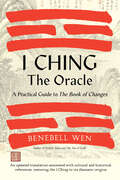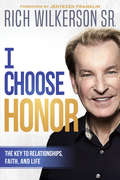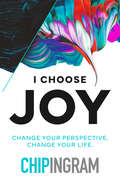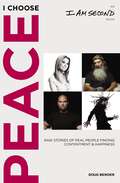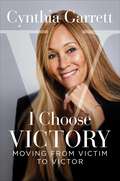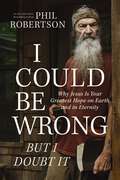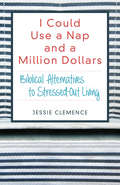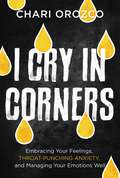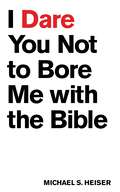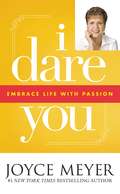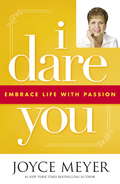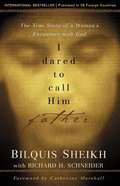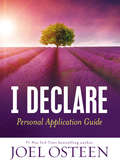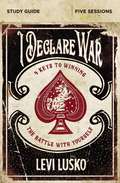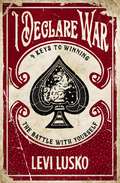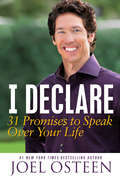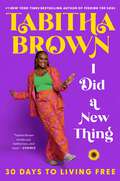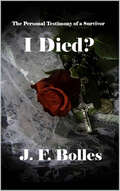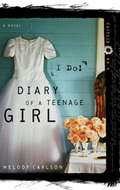- Table View
- List View
I Ching, the Oracle: A Practical Guide to the Book of Changes: An updated translation annotated with cultural and historical references, restoring the I Ching to its shamanic origin
by Benebell WenBenebell Wen&’s (Holistic Tarot and The Tao of Craft) historic new translation of the I Ching brings the power and mysticism of The Book of Changes to contemporary readers.Now in a beautiful hardcover format with a ribbon bookmark.Through in-depth annotations, cultural and historical references, and magical practices, Wen amplifies the wisdom—both profound and practical—of the 3,000-year old text. She includes aspects of the I Ching that have never before been translated into English, offering fresh perspectives on a classic work. Rooted in her experience and knowledge as a Taiwanese-American occultist and Buddhist with deep family ties to Taoist mysticism, Wen's groundbreaking translation is accompanied by a critical analysis of earlier I Ching transmissions.Readers will learn how to: Situate the I Ching within its historical and cultural contextInterpret the hexagrams and utilize various divination methods, such as yarrow stalk, coin toss, cowrie shells, and rice grainsWork with the I Ching for personal guidance and developing intuitive wisdomUnderstand correspondences of Taoist mystical tradition with other schools of metaphysics, including shamanism, faith healing, and soul retrieval Approach the Book of Changes as a grimoire and attain a foundational understanding of the eight trigrams and Wu Xing five alchemical phasesWhether you&’re new to the I Ching or an experienced occultist, I Ching, The Oracle will deepen your understanding of esoteric Taoism and the art and craft of divination. Highlighting the two main schools of interpretation—Image and Numbers and Meanings and Principles—and exploring Taoist cosmology, mysticism, ritual practice, and the shamanic origins of the I Ching, Wen provides you with everything you need to apply the I Ching for life guidance, spiritual practice, and ancestral connection.
I Ching: The Book of Change
by David HintonA master translator's beautiful and accessible rendering of the seminal Chinese textIn a radically new translation and interpretation of the I Ching, David Hinton strips this ancient Chinese masterwork of the usual apparatus and discovers a deeply poetic and philosophical text. Teasing out an elegant vision of the cosmos as ever-changing yet harmonious, Hinton reveals the seed from which Chinese philosophy, poetry, and painting grew. Although it was and is widely used for divination, the I Ching is also a book of poetic philosophy, deeply valued by artists and intellectuals, and Hinton's translation restores it to its original lyrical form.Previous translations have rendered the I Ching as a divination text full of arcane language and extensive commentary. Though informative, these versions rarely hint at the work's philosophical heart, let alone its literary beauty. Here, Hinton translates only the original strata of the text, revealing a fully formed work of literature in its own right. The result is full of wild imagery, fables, aphorisms, and stories. Acclaimed for the eloquence of his many translations of ancient Chinese poetry and philosophy, Hinton has reinvented the I Ching as an exciting contemporary text at once primal and postmodern.
I Choose Honor: The Key to Relationships, Faith, and Life
by Rich Wilkerson Sr.When you honor others, you honor God. Trying harder doesn&’t always improve relationships or bring promotion. But choosing to live with honor will strengthen relationships, bring elevation, build bridges, and deepen our worship of and intimacy with God. The blessing of honor is seen throughout Scripture, as those who remained honorable flourished, and those who did not suffered from tragedies, wars, and hardships. This book explains that when we honor family members, authority figures, the overlooked, colleagues, subordinates, and the like simply because they are God&’s creation, we honor God. And honoring God is an act of worship that leads to a deeper intimacy with Him. While some self-improvement and leadership books address the importance of respect, few explain the life-changing power of honor. Through biblical examples and personal stories, this book will help readers grow closer in their relationship with Jesus and truly appreciate the people around them as they learn to create a culture of honor in their lives, families, and ministries.
I Choose Joy: Change Your Perspective, Change Your Life
by Chip IngramJoy—our lifeline and strength through life&’s suffering.C.S. Lewis said, "Joy is the serious business of Heaven.&” Too often, however, joy is missing from our lives. When we look to Scripture, we see examples of early Christians thriving even amid hardship and persecution. How do we recapture that deep and stubborn joy? Pastor and author Chip Ingram takes us to God&’s Word, helping us shift away from self-centered happiness and toward lasting joy found in God&’s goodness. &“Choosing joy in the midst of difficulties goes against all our instincts. When you look at life through the lens of your circumstances, what happens? You&’re happy when circumstances are good and sad or angry when they aren&’t, right? But if you look at your circumstances through the lens of God&’s goodness—his power and promises—that&’s a higher perspective. You can experience joy because you know a good God is going to take even the worst and most difficult things in life and use them for your good. Living above our circumstances occurs when our perspective interprets our circumstances rather than our circumstances determining our perspective.&”You cannot choose your life&’s circumstances, but you can choose how to respond. Join esteemed Bible teacher, Chip Ingram, on this journey to restore the essential Christian virtue of JOY!
I Choose Peace: Raw Stories of Real People Finding Contentment and Happiness (An I Am Second Book)
by Doug BenderFrom the influential and ever-growing movement "I Am Second" comes a remarkable collection of well-known lives transformed from restless to happy by the power of God.When I Am Second launched in 2008, the organization meant simply to tell stories of people whose lives changed utterly when they placed God first and themselves second. Although the organization has exploded in size and influence since, that original mission has remained the same--and continues to have enormous power today. I Choose Peace is the highly anticipated new book from I Am Second, gathering together stories of people who searched everywhere for fulfillment and wholeness and found it only when they surrendered to God. People whose stories appear include the following:Chip and Joanna GainesKathie Lee GiffordAlbert PujolsShawn JohnsonPhil and Kay RobertsonBrian "Head" WelchMoving, compelling, and profoundly inspiring, the stories found here remind us that our hearts will always be restless until they find their rest in God.
I Choose Victory: Moving from Victim to Victor
by Cynthia GarrettHow does one rise above negative circumstances to win at life? How do you break strongholds? Author Cynthia Garrett peppers a wealth of practical advice with anecdotes from her riches-to-rags-to-riches testimony as she walks readers through their personal, spiritual, and political war zones into the victory God promises all believers.
I Choose You Today: 31 Choices to Make Love Last
by Deb DeArmondMarried for nearly 38 years, author Deborah DeArmond and her husband have made the spoken declaration, "I choose you today" a regular part of their communication. It’s when we least feel like saying it that we need to remind ourselves that love is a choice, not a feeling. I Choose You Today features 31 scriptural principles that support marriage and help couples develop healthy biblically based behavior.Built on an introductory anecdotal story, each chapter has an inspirational takeaway of not only what to do, but how to begin applying the principles immediately. Thought provoking questions create talking points for couples to explore their own choices and experiences in each area serve to generate open dialogue of discovery. I Choose You Today is not a book of "shoulds," but one of clearly identified choices that each individual can make to grow their marriage and align it with the word of God. Every saying ends with a conventional wisdom quote.
I Could Be Wrong, But I Doubt It: Why Jesus Is Your Greatest Hope on Earth and in Eternity
by Phil RobertsonDiscover the completely unique qualifications and accomplishments of Jesus Christ--the Creator of everything, the King who will set you free, and the best friend you could ever have.Over nearly five decades of walking with God, podcaster, author and Duck Dynasty star Phil Robertson has learned a thing or two about why Jesus is the only one worth following. Of all the things we could put our trust in, only Jesus has the answers to our questions and the solutions for our problems.Plenty of people claim to have the answers for a better life. Politicians claim they can fix our nation. Scientists and technologists trumpet the latest and greatest discoveries that'll make everything right. Self-help gurus offer one pathway to peace after another. But it's no secret that our world is increasingly divided and broken--and we've got the fear, anxiety, and hopelessness to prove it. Jesus alone can make good on the promise of lasting peace, real freedom, and life eternal.With his trademark directness, humor, and insight, Phil will help youexperience Jesus as the Creator and all-powerful Sustainer of all creation;reconcile your own brokenness and sinfulness with Jesus&’ unending well healing, forgiveness, and peace;develop the eyes to see Jesus for who he really is: the friend who will always be there for you, no matter what mistakes you've made; andlook to the Bible to get to know Jesus and better understand His grace and love for you.Politics won't save you. Science can't give you the power to sidestep death. The pleasures and joys of this world are fleeting at best, damaging counterfeits at worst. But Phil has good news for you: Jesus offers life, joy, and peace, and he's never more than a prayer away.Look for additional bold, biblical content from Phil:UncanceledJesus PoliticsTheft of America&’s SoulYour Daily Phil
I Could Use a Nap and a Million Dollars: Biblical Alternatives To Stressed-out Living
by Jessie ClemenceHumorous, heartfelt observations on life from an everymom trying to follow GodToo often, women wonder if the abundant life Jesus promised is buried somewhere beneath the piles of dirty laundry or the layers of crumbs and abandoned toys on the floor of the minivan. Overwhelming to-do lists--pay the bills, go to work, parent the children, volunteer at church, bake four dozen cupcakes before bed--can feel like weights around their necks.Jessie Clemence knows the struggles of women everywhere who are just trying to get through the million stresses--small and large--that come with living day to day. This funny, warm, and honest book speaks directly to them, and offers real hope.With hilarity and wit sure to make every mom chuckle in recognition, Jessie discusses what the Bible says about reactions to daily frustrations and God's expectations for Christians' lives. For any overwhelmed woman wanting a new way of handling life's crazy moments, God is waiting to offer abundant life, peace, and joy--all found through seeking Him.I Could Use a Nap and a Million Dollars will give readers a respite, time to laugh out loud, and a new focus on the God who can turn their stresses into blessings.
I Cried, He Answered: A Testimony to Answered Prayer (Colportage Library #138)
by William Norton Henry W. Adams Norman Camp F. A. StevenI Cried, He Answered contains about 125 authentic and most readable testimonies to answered prayer granted under many and widely varied conditions of human experience. Each incident is properly classified and carefully indexed by exact subject with a view to immediate reference. The introduction by Charles Trumbell, though brief, amounts to a very practical and illuminating study of prayer and its real meaning. This book will be an encouragement to all followers of Christ, bringing home to them a fresh realization of the omnipresence and providence of God.
I Cried, He Answered: A Testimony to Answered Prayer (Colportage Library #138)
by William Norton Henry W. Adams Norman Camp F. A. StevenI Cried, He Answered contains about 125 authentic and most readable testimonies to answered prayer granted under many and widely varied conditions of human experience. Each incident is properly classified and carefully indexed by exact subject with a view to immediate reference. The introduction by Charles Trumbell, though brief, amounts to a very practical and illuminating study of prayer and its real meaning. This book will be an encouragement to all followers of Christ, bringing home to them a fresh realization of the omnipresence and providence of God.
I Cry in Corners: Embracing Your Feelings, Throat-Punching Anxiety, and Managing Your Emotions Well
by Chari OrozcoIt's easy to get lost in all the feels. Our emotions drive so much of what we do, say, and think, even if we don&’t realize it. Our response to our feelings—denying they exist, letting them lead our actions unchecked, distracting ourselves to avoid feeling them—can greatly impact our lives and those around us. Emotions are essential for everyday life, but how we navigate them in the storms of life will make or break us. In I Cry in Corners, pastor Chari Orozco takes the readers through the life of Jesus, examining the powerful emotional tests he faced and how he responded, from his terror in the Garden of Gethsemane to his righteous anger in the temple to his disappointment when those he loved best betrayed him. In each chapter, Chari gives readers both practical and spiritual wisdom to help them respond to emotions like Jesus did. How do we steward our emotions when those closest people fail us? We turn around and wash the feet of the ones we love. How do we face temptation? We refuse to get hangry, resist the devil, and remember that our value lies not in what we have but how we love. How do we steward our emotions with maturity when the hurt we&’ve suffered comes from those who claim to know and love Jesus? We do what Jesus did: choose our words wisely, keep our eyes on the joy set before us, and, if necessary, flip over some tables. Our feelings are a gift from God, and through the life and struggles of Jesus, we find a blueprint for honoring your feelings without getting lost in them. Written with a wry, straight-talking, irreverent but always faithful tone, Chari effortlessly weaves together stories of the New Testament with her own insightful, humorous, and refreshingly candid anecdotes. The resulting book is an affirmation of feeling all the feels while encouraging readers to use their emotions as a catalyst for deep spiritual growth.
I Danced: A Cochlear Implant Odyssey
by Dora Tingelstad Weber<P>Weber presents a readable yet comprehensive look at cochlear implants and shares her own story: <br>why did she choose to hear? <br>how did she cope? <br>what were the frustrations with implants? <P>The book includes some technical information and lists of resources for those with hearing disabilities.
I Dare You Not to Bore Me with The Bible
by Michael S. HeiserThe Bible is filled with passages that are so baffling we tend to ignore them. Yet the passages that seem weird might be the most important. This collection of essays from Bible Study Magazine will shock you, intrigue you, and completely change the way you view the Bible. Dr. Michael S. Heiser visits some of the Bible's most obscure passages, unveiling their ancient context to help you interpret them today. Read this book, and you'll never be bored by the Bible again. Part One: Old Testament The Ancient's Guide to the Galaxy Walk Like an Israelite Even the Bible Needed Upgrading Spellchecking the Bible Why Circumcision? The Abandoned Child and the Basket Case A Tale of Courage We Never Teach Counting the Ten Commandments Is There Really a Sin Offering? There's a Devil in the Details Love Potion: Numbers 5 Is My Bible Right? The Most Horrific Bible Story Righting a Wrong When Giants Walked the Earth The Divine Arrow Promise Undelivered? Sanctified Dirt 1003 BC Census: Who Authorized It-God or Satan? Cookin' the Books Slaying the Sea Monster Does God Need a Co-Signer? The Witness in the Clouds Who Wrote the Book of Proverbs? Immanuel's Mother: Virgin or Not? Standing in the Council Jeremiah: Double Vision? Why the Ark of the Covenant Will Never Be Found He, Him, Me, Myself, and I Bizarre Visions for the Worst of Times Do the Dead Sea Scrolls Answer the Canon Question? Part Two: New Testament Burying Hell My Guardian Angel The New Testament Misquotes the Old Testament? "I Saw Satan Fall like Lightning": When? The Healing Serpent Who Took Verse 4 out of My Bible? What Walking on Water Really Means Born Again ... and Again and Again? Dumbledore Meets Philip & Peter Paul's Lost Letters Destiny & Destination A Female Apostle Signed, Sealed, and Delivered-to Satan? Treason & Translation Charlton Heston Had Company When Abraham Met Jesus How Many Times Is Jesus Coming Back? What's Jesus Waiting For? God's Right-Hand Woman? Wisdom in Hebrews Baptism as Spiritual Warfare Jesus Is God: Jude and Peter Tell Me So When Angels Do Time Tough Love Jesus, God, a.k.a., The Name 666: What Theories Add Up? Perspective Changes Everything Co
I Dare You: Embrace Life with Passion
by Joyce MeyerJoyce Meyer explains that a life without purpose is a life not worth living. We all need a reason to get up everyday. We all need to reach for something beyond ourselves. Over the centuries, millions of people have asked, "What am I here for? What is my purpose?" We are born; we live; and we die. We cannot do anything about being born or dying, but we can do a lot about how we live.
I Dare You: Embrace Life with Passion
by Joyce MeyerI Dare You is The Purpose-Driven Life, Joyce Meyer style!Joyce Meyer explains that a life without purpose is a life not worth living. We all need a reason to get up every day. We all need a reason to reach for something beyond ourselves. Over the centuries, millions of people have asked, 'What am I here for? What is my purpose?' The more important question is 'How can I live today?'Taking responsibility for how we live takes courage. To accept life as it is comes to us and to be determined to make the most we can out of it is a big challenge. Joyce challenges her readers to make sure they live their lives with purpose and passion.
I Dared To Call Him Father: The Miraculous Story Of A Muslim Woman's Encounter With God
by Bilquis Sheikh Richard H. SchneiderI Dared to Call Him Father is the fascinating true story of Bilquis Sheikh, a prominent Muslim woman. Her unusual journey to a personal relationship with God turned her world upside down-and put her life in danger.
I Declare Personal Application Guide
by Joel OsteenWords have power. Whenever we speak something either good or bad, we give life to what we are saying. In his bestselling book, I Declare, Pastor Joel Osteen reveals 31 declarations that can bring God's favor and blessing to the reader's life in a greater way.Now, Joel Osteen offers a practical tool that will help ensure that what you say about yourself and others are positive, inspiring, and encouraging. In using this personal application guide, you will be encouraged to declare God's Word over your life each day through insightful reflection and a relevant scripture verse-all of this with space in which to record your own thoughts and revelations. This lively guide offers all of this and more, with the expectation that God will use it to help you see His favor and blessings in a greater way.So if you want to know what life will be like five years from now, take this faithful companion in hand, and begin the next 31 days with the only One who has the power to bless the future.with the only One who has the power to bless your future.
I Declare War Bible Study Guide: Four Keys to Winning the Battle with Yourself
by Levi LuskoLearn how to win the war in your mind by filling your heart with the truth of the Holy Spirit and defending yourself against harmful thought patterns. Whether you recognize it or not, you're at war with yourself. Anxiety--Selfishness--Self-sabotaging tendencies--Narcissism--The black dog of depression...But whatever your battle may be, all is not lost. You can win...if you choose to engage.In this five-session video Bible study (DVD sold separately), Levi Lusko explains how you can fight this battle by declaring war on your thoughts, your words, and your actions. Levi candidly shares about his struggles with moodiness, bullying, suicidal thoughts, and night terrors to show how you--with the help of the Holy Spirit--can achieve victory by learning to think right so you can live right. So that you can claim the victory God has for you.The I Declare War Study Guide includes:Video teaching notesDiscussion questionsBible explorationWeekly personal studyReflection materialsSessions include:It's Time to Declare WarDeclaring War on Your ThoughtsDeclaring War on Your WordsDeclaring War on Your ActionsYour Secret Weapon in the BattleIt's time to stop being your own worst enemy. It's time to declare war and become the person, the spouse, the parent, the leader God intended you to be.Designed for use with I Declare War Video Study (9780310094913), sold separately.
I Declare War: Four Keys to Winning the Battle with Yourself
by Levi LuskoWe all battle inner struggles—whether it's self-doubt, depression, fear, or anger. It&’s time to get out of your own way.Whether you recognize it or not, you're at war with yourself. There's anxiety. Selfishness. Self-sabotaging tendencies. Narcissism. Depression. The inability to do the great things you long to do because you spend so many hours mindlessly drifting through the internet.It is war, but all is not lost. You can win—if you choose to engage.In I Declare War, Levi Lusko candidly shares his struggles with moodiness, bullying, suicidal thoughts, night terrors, and difficulty managing himself. He identifies four weapons you have at your disposal—thoughts, words, behaviors, and power—and illustrates how to use them to achieve ongoing victory. These practical tools from God&’s Word will help you learn to:Retaliate against your anxiety by filling your heart with truth and making it inhospitable to terrorStop being victimized by your bad behaviors and become the victor you were born to be Overcome self-imposed isolation by learning to think right so you can live rightSpare your family unnecessary heartache by confronting your dysfunction so they don&’t have toIt&’s time to stop being your own worst enemy. Declare war and become the person, the spouse, the parent, and the leader God intended you to be.
I Declare: 31 Promises to Speak Over Your Life
by Joel OsteenBroken into thirty-one segments, this book defines the most powerful blessings in Scripture and encourages readers to declare one each day for a month. The declarations will affirm God's blessings in the area of health, family legacy, decisions, finances, thoughts, outlook, and overcoming obstacles.
I Did a New Thing: 30 Days to Living Free (A Feeding the Soul Book)
by Tabitha BrownNEW YORK TIMES BESTSELLER“America’s Mom” Tabitha Brown presents an inspirational guide for encouraging positive changes in your life—one day and one challenge at a time.I did a new thing today!Years ago, Tabitha Brown started a 30-day personal challenge that she called “I Did a New Thing!” The challenge was simple. Every day she would do something she’d never done before. Sometimes it was something small like trying a new food. Other times, she’d step it up a bit and speak to someone she’d never spoken to before. Still other times, she’d do the hard thing—facing a fear that she had, like having that tough conversation with a friend. No matter what it was, the point was that she was going to take a leap of faith and watch God open up a new lane for her.One of the “new things” she tried was a vegan challenge. She’d been struggling with illness for nearly a year and was desperately searching for healing. She challenged herself to eat vegan every day for thirty days, and six years later, her life has never been the same—all because she decided to do a new thing.In I Did a New Thing, Tab shares her own stories and those of others, alongside gentle guidance and encouragement to create these incredible changes for yourself and see what good can come from them. Whether that means having the hard conversation or trying for a promotion or simply wearing something different or doing something kind for someone else, Tab has a plan for you: Try one new thing, every single day, for thirty days. You don’t have to wait until Monday or the beginning of a new month or year to get started. There’s no set time and place or any extra preparation required. All you have to do is show up for yourself. And that can start right now.
I Died?: The Personal Testimony of a Survivor
by J. F. BollesA spot of illness before Thanksgiving marks the beginning of one woman’s heart-rending, real-life journey from pain and death to survival and happiness. J. F. Bolles is a mother, a grandmother and a Christian. J. F. Bolles died, twice! She received a second chance from God to live and to love. This is her personal testimony.
I Do
by Melody CarlsonCaitlin O'Conner, now 21 and in her senior year of college, accepts Josh Miller's proposal for marriage. But Caitlin soon discovers there's a lot more to getting married than just saying "I do." Between her mother and mother-in-law to be (who don't seem to agree on anything) and Caitlin's old buddies (who still have problems of their own because of wrong choices), Caitlin's life never seems to run smoothly. But Caitlin, as determined as ever to do things God's way, always manages to find the high ground...eventually. As a result, the journey to her wedding is full of twists and turns where God touches many lives, including Caitlin's. Most of all, Caitlin and Josh realize that a wedding only lasts one day, but a marriage is for a lifetime.Saturday, October 22 My life changed today. It's as if I got up this morning as one person and will go to bed as someone else. Okay, maybe it's not THAT drastic. But I'm so excited I'm not sure I'll ever go to sleep tonight. Josh Miller asked me to marry him! First she "kissed dating goodbye." Now, several years later, Caitlin O'Conner is getting married-to the guy she's loved all along, Josh Miller! It's her senior year of college, and she has seven months to plan her wedding...but according to Josh's mom, that's not enough time. Meanwhile, Caitlin's roommate, Liz, has ditched her to move in with a boyfriend. Her new roommate and old friend, Jenny, is toying with anorexia again, and just when Caitlin needs her most, Beanie heads off to a New York City design school. On top of all this, an issue from Josh's past rocks Caitlin's emotions. Can she handle it all? True to form, Caitlin is more concerned with following God than having the perfect wedding. But it is her big day. Can Caitlin have a lovely ceremony without spending a small fortune? Will she remember it's the marriage-and not the wedding-that lasts forever? Story Behind the Book"My teenage years remain vivid in my mind. It was a turbulent time full of sharp contrasts- love and hate, pain and pleasure, trust and doubt. Then, just as I reached my peak of questioning, rebelling, and seeking, I found God. And I found Him in a really big way! My life turned completely around and has, thankfully, never turned back. Hopefully this story will touch and change hearts-speaking to teen girls right where they live, reminding readers that God is alive and well and ready to be intimately involved in their lives right now! Caitlin provides a very positive role model for girls. And her wedding is a great way to teach them about the things that really matter in life-their relationship with God and their willingness to be used by Him."From the Trade Paperback edition.
I Do
by Melody CarlsonSaturday, October 22 My life changed today. It's as if I got up this morning as one person and will go to bed as someone else. Okay, maybe it's not THAT drastic. But I'm so excited I'm not sure I'll ever go to sleep tonight. Josh Miller asked me to marry him! First she "kissed dating goodbye." Now, several years later, Caitlin O'Conner is getting married-to the guy she's loved all along, Josh Miller! It's her senior year of college, and she has seven months to plan her wedding...but according to Josh's mom, that's not enough time. Meanwhile, Caitlin's roommate, Liz, has ditched her to move in with a boyfriend. Her new roommate and old friend, Jenny, is toying with anorexia again, and just when Caitlin needs her most, Beanie heads off to a New York City design school. On top of all this, an issue from Josh' s past rocks Caitlin's emotions. Can she handle it all? True to form, Caitlin is more concerned with following God than having the perfect wedding. But it is her big day. Can Caitlin have a lovely ceremony without spending a small fortune? Will she remember it's the marriage-and not the wedding-that lasts forever? Story Behind the Book "My teenage years remain vivid in my mind. It was a turbulent time full of sharp contrasts- love and hate, pain and pleasure, trust and doubt. Then, just as I reached my peak of questioning, rebelling, and seeking, I found God. And I found Him in a really big way! My life turned completely around and has, thankfully, never turned back. Hopefully this story will touch and change hearts-speaking to teen girls right where they live, reminding readers that God is alive and well and ready to be intimately involved in their lives right now! Caitlin provides a very positive role model for girls. And her wedding is a great way to teach them about the things that really matter in life-their relationship with God and their willingness to be used by Him."From the Trade Paperback edition.. Then, just as I reached my peak of questioning, rebelling, and seeking, I found God. And I found Him in a really big way! My life turned completely around and has, thankfully, never turned back. Hopefully this story will touch and change hearts-speaking to teen girls right where they live, reminding readers that God is alive and well and ready to be intimately involved in their lives right now! Caitlin provides a very positive role model for girls. And her wedding is a great way to teach them about the things that really matter in life-their relationship with God and their willingness to be used by Him."From the Trade Paperback edition.
